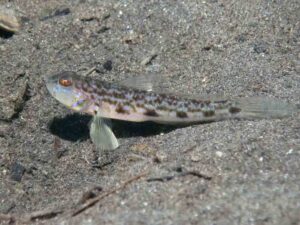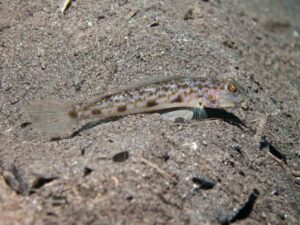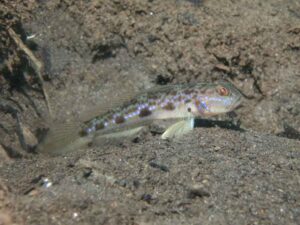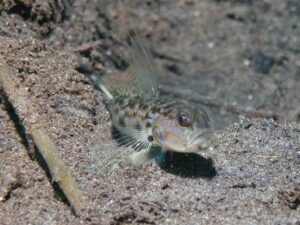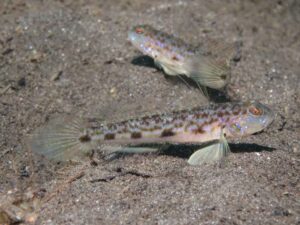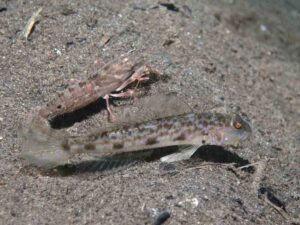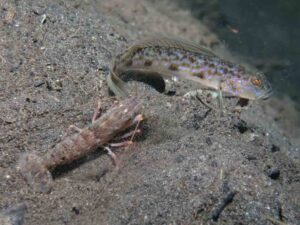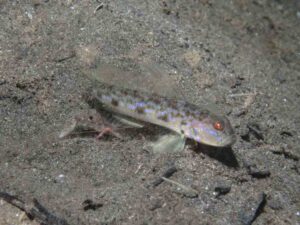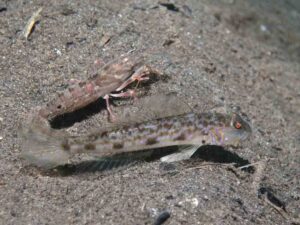Cenderawasih Goby
Acentrogobius cenderawasih
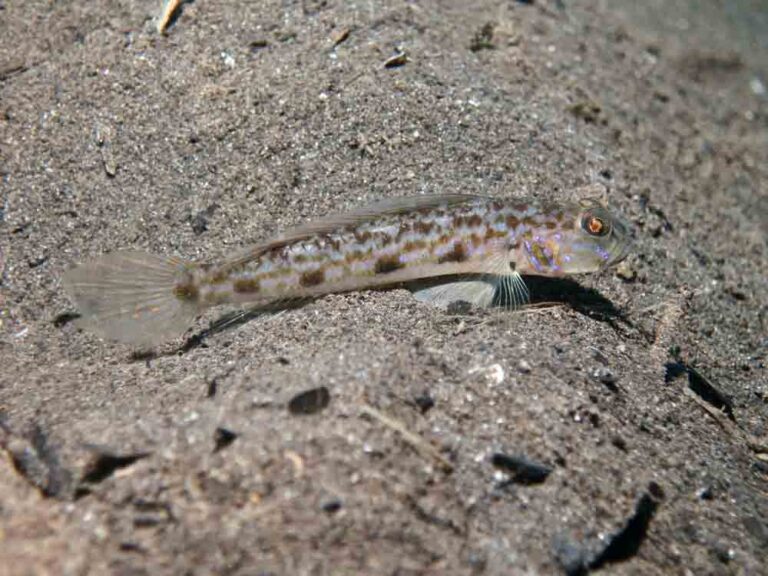
Cenderawasih Goby
Acentrogobius cenderawasih
Allen and Erdmann, 2012
Description
Body Design
A small to medium-sized goby approximately 5 cm long, grey above and cream-coloured below. There are large irregular brown blotches dorsally on the head and upper half of the body. The mid-lateral zone is marked with five horizontally elongated dark brown blotches. In suitable light, each of these short segments is surrounded by iridescent blue spots. There is a small black spot above and below the base of the pectoral fin.
The head with diffuse blue, gold and brown markings and a larger blue patch on the lower operculum.
Fin design
The first dorsal fin is translucent grey with faint brown spots. The rays have filamentous extensions well beyond the fin margin. The second dorsal fin is blue-grey with orange spots. The pectoral fins are transparent with a black spot at the top and bottom of the base. The pelvic fins are opaque and cream-coloured with a blue reflection anteriorly. The anal fin is translucent with a cream-blue horizontal mid-zone. The caudal fin is rhomboid, translucent with the rays blue. There are faint reddish-yellow spots over the tail.
Diagnostic features
This fish could easily be confused with Vanderhorstia species. The colour and markings are similar though behaviour is different.
The small size, long-rayed first dorsal fin and the black spot above and below the base of the pectoral fin may be helpful features.
Taxonomy
The genus Acentrogobius is probably a phylogenetic assemblage. It may be a combination of the genera Amoya, Acentrogobius, Yongeichthys and another as yet unnamed genus. A. cenderawasih would probably belong to Yongeichthys but be retained in this genus until the taxonomy has been published (Allen 2015).
Acentrogobius cenderawasih is not a known shrimpgoby but we have included a species account as it seems from our observations to have a facultative relationship with an Alpheid shrimp. This has not been confirmed so far by other observers such as Gerry Allen who has recently done several dives in nearshore muddy habitats looking at and finding new species of this genus. They do live in a habitat occupied by shrimpgobies leading a solitary scattered life and are always associated with burrows to which they retreat when threatened.
Natural History
Facultative relationships
When the shrimp and goby relationship is well established the shrimpgobies and their partner shrimps have a consistent stereotyped set of behavioural and communication patterns This relationship is said to be obligate. When the pattern is incomplete, communication is inconsistent and behaviour unpredictable the relationship is called facultative. In this case, the shrimp maintains less consistent antenna contact and the goby tends to spend time away from the burrow.
There are well-studied examples of facultative behaviour from the eastern Atlantic and Caribbean (Karplus 1992, Randall et al 2005, Karplus and Thompson 2011, Lyons 2012, 2013, 2014 ). In these studies, gobies in obligate and facultative relationships with the shrimp Alpheus floridanus were compared. Gobies in obligate relationships compete more strongly for burrows than those in facultative relationships and with smaller members of their species. This is understandable as they have more to lose. At the same time, this behaviour may perpetuate the status quo and impede the acquisition of obligate relationships among those in facultative ones. This is to imply that a facultative relationship is an intermediate stage in the evolution of an obligate one. However, the latter comes with a cost, loss of foraging and mate acquisition opportunities, so the goby must have beneficial physiological and behavioural traits for the adaption to be worthwhile. It could be argued that gobies in a facultative relationship lack these traits, have other ones and will not evolve into a fully obligate partnership.
All the shrimpgoby species in this site have obligate relationships except the current species, Acentrogobius cenderawasih a species recently described by Allen and Erdmann (2012) from Indonesia and on which we carried out the following observations in the Solomon Islands.
Habitat
We have found these gobies living on steep slopes at 8 to 14m in a protected black-sand bay, outside of which was a fringing reef with a vertical drop-off to 200 metres washed by strong current. There was some freshwater runoff from a creek in the bay. The sand was fine and quite silty with a large percentage of organic matter left over from logging activity at this site.
Behaviour
The gobies were mostly seen at the burrow entrances but tended to wander away. The shrimps were only observed occasionally but when present were seen to maintain antennae contact with the goby. Gobies defended burrows from each other by displaying, with fins erected and mouths open. This species has not previously been seen with shrimps and this is the first record of gobies of this genus having this association.
This is the first record of this species having a facultative relationship with a partner shrimp. The genus Acentrogobius has over 20 species and is not considered to form partnerships with shrimps although there is one species Acentrogobius pflaumi that has been reported to form such a bond (Yanagisawa 1978), and Harada (1969) quotes Tagaki (1966) as saying that Acentrogobius is a known “commensal” in the burrow of the common snapping shrimp Alpheus brevicristatus,
We have discussed this with Dr Gerald Allen the describer of this species.
Allen’s Observations
At the time of its description in 2012, this species was known only from the type locality, a narrow gully on a relatively steep silty sand slope that gradually levelled out at 30 metres. This was in Cenderawasih Bay in Eastern Indonesia. (Allen and Eardmann 2012)
Dr Gerald Allen found about ten solitary individual fish in the gully in Indonesia. Each was associated with a sandy burrow into which it quickly disappeared when approached. The type specimens were not seen to be associated with shrimp despite careful observation. (G Allen pers com)
More field observations are needed. In the meantime, we have included Acentrogobius cenderawasih in this account as a possible facultative shrimp goby.
We have another observation, from the Low Isles. A small goby, so far unidentified lurks around the silty sand habitat that is home to several shrimpgobies and their shrimps. When threatened it flees into a burrow. It does not appear to have a fixed burrow as it moves around too much. We have seen and photographed this goby at a burrow entrance while a shrimp working nearby maintained antenna contact. This is not consistent behaviour but it does suggest some special affinity as aquarium observations show two outcomes when a partner shrimp makes contact with a fish other than a shrimpgoby. Either the shrimp drives the fish away with its major chelipeds or the fish retreats on feeling the touch of the shrimp’s antennae (Harada 1969).
Harada (1969) quotes Tagaki (1966) as saying that Acentrogobius is a known “commensal” in the burrow of the common snapping shrimp Alpheus brevicristatus, (A pflaumi, A. koumansi), together with Vireosa, Lotilia, Ctenogobiops and Apocryptodon.
Distribution
Published distribution: Only recorded from Cenderawasih Bay, Eastern Indonesia and the Philippines.
Our record: (Range extension)
Solomon Islands, Pigpen Bay, near Vanga, Kolombangara Island.
Associated Shrimp species
Associated Shrimps (one shrimp)
Pigpen Snapping Shrimp

